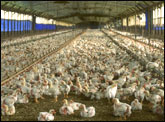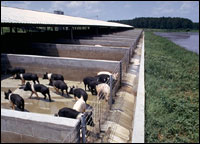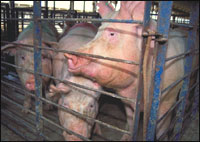What do the National Chicken Council, the National Turkey Federation, United Egg Producers, and Tyson Foods have in common?

Crying fowl.
Photo: USDA.
Well, first there’s the obvious fowl connection. Then there’s the foul connection: Their facilities, known as “concentrated animal feeding operations” (CAFOs), have growing air-pollution problems thanks to the mountains of gas-emitting excrement deposited daily by their tens of thousands of cooped-up feathery charges.
These industry groups also share another connection: membership in the Ag Air Group, a coalition of special interests that includes the National Pork Producers Council and the National Milk Producers Federation (whose hogs and heifers also contribute to malodorous air-quality problems). The group has been helping the Bush EPA create an air-monitoring program that would allegedly pave the way for regulation of this escalating and, at present, virtually unregulated problem — but the program has a stench all its own.
Over the past decade, the livestock industry has steadily expanded and CAFOs have grown increasingly concentrated, displacing smaller, family-owned farms. As more animals are packed into massive factory farms, the facilities produce ever larger heaps of excreta, which emit noxious air pollutants, including ammonia and hydrogen sulfide, both of which are on par with cyanide and arsenic as hazardous substances, as well as volatile organic compounds and particulate matter from fecal dust.
In the past 10 years, nearly a dozen people have died in CAFOs in the U.S. from exposure to these gases, and according to a study released in February 2002 by Iowa State University and the University of Iowa Study Group, up to 70 percent of workers exposed to pollutants at CAFOs in the U.S. are afflicted with acute bronchitis and 25 percent with chronic bronchitis.
The EPA, though it has taken a number of legal actions against factory farms over surface and groundwater pollution, has been notably slow to act on air-quality problems at CAFOs, despite escalating calls from the environmental community to address the issue.
Michele Merkel, a former staff attorney in the EPA’s enforcement division, filed the agency’s first suit against a CAFO for Clean Air Act violations in October 1999, under the Clinton administration. The suit charged Premium Standard Farms — a pork company that raises more than 2.5 million pigs a year and produces more sewage than the city of St. Louis — with violating clean-air standards, and was settled out of court. A second such suit filed by the EPA was also settled out of court.

Going whole-hog alongside a waste lagoon.
Photo: USDA.
But the Bush administration put the kibosh on these enforcement efforts, according to Merkel. “Once the Bush team came in, I was not allowed to pursue any further air lawsuits against CAFOs,” she told Muckraker. “We got political cover to continue what was underway, but I was told that new efforts were off-limits. It wasn’t just coming from my EPA superiors, it was coming from the White House.” Merkel found it so demoralizing to see the enforcement process hamstrung that she quit.
“But now the problem is only getting worse,” she said. “The negligence is leading to a growing incidence of respiratory problems, not to mention olfactory discontent, among the residents in neighboring towns.”
Merkel now works at the nonprofit Environmental Integrity Project, which recently joined the Sierra Club in an effort to obtain under the Freedom of Information Act hundreds of pages of emails and meeting records that reveal the backroom negotiations between industry and the EPA as they worked to devise a CAFO-friendly air-regulation program.
The documents, first exposed Sunday in a Chicago Tribune article by Andrew Martin, reveal that the latest draft of the program [PDF], which the EPA intends to release this summer, is remarkably similar to the program proposal [PDF] submitted to EPA in June 2002 by a lawyer and a lobbyist for the Ag Air Group. There’s also evidence that EPA officials used a PowerPoint presentation drafted by an industry lobbyist as they explained the proposed air-monitoring program at a National Pork Producers Council meeting last year.
What’s the program all about? As enviros see it, the factory-farm industry realized it was a sitting duck, out of compliance with Clean Air Act rules and a prime target for lawsuits, so it approached the EPA with a deal that would stem the threat of litigation. Industry people freely admit concerns about lawsuits: “We don’t want to face haphazard, expensive lawsuits,” said Richard Schwartz, a lawyer for the Ag Air Group. “It’s like being struck by lightning — that’s how random it is.”

Some pig.
Photo: USDA.
The program would insulate CAFOs from clean-air enforcement efforts if they volunteer to participate in a two-year monitoring program to measure their air emissions. In 2007, they would be asked to come into compliance with the Clean Air Act during a 120-day “cure period” — essentially having bought a couple of years of extra time to clean up their acts.
Industry and EPA officials characterize the program as a way to gather emissions data that can be used down the road to create a solid regulatory program; they point out that current methods for measuring CAFOs’ emissions are rudimentary and not standardized, so study in this area is needed. “We need standards that will level the playing field and do away with these uncertainties,” said Schwartz.
Enviros agree on the need to formulate better standards, but they argue that the EPA doesn’t need to cozy up to industry in the process. “The EPA has fully within its authority the power to order the production of air-quality data at each facility that’s conducted with a single, standard, government-controlled test, without entering into a deal with industry,” said Sierra Club attorney Barclay Rogers, who led the FOIA request.
To take part in the program, a company would be asked to pay a “penalty” (or as critics call it, an “admissions fee”) of between $200 and $1,000 per factory farm, depending on the size and number of farms it owns, plus a flat per-factory fee of $2,500 to fund monitoring efforts.
“That’s a pittance compared to the statutory penalties available under the Clean Air Act, which are $27,500 per day of violation,” said Rogers.
Schwartz made no bones about the program’s potential advantages to industry in — where else? — Pork magazine. “[Y]ou can view it as a very cheap insurance policy,” he’s quoted as saying in a May 7 article.
However, he told Muckraker that the program was a reflection of industry’s charitable inclinations — not the EPA’s. “To my knowledge, this is the first time industry has gone out of its way to pay for a study to determine its own emissions,” he said. “It is extraordinary, that’s for sure!”
The EPA did not respond to Muckraker’s request for comment.
Rogers is hopeful that the EPA will decide against formally implementing the program, but if the agency goes forward with it, “of course we’ll contemplate the appropriate legal actions,” he said.

